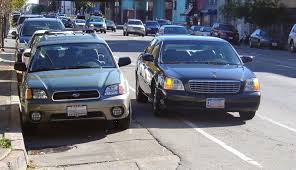Physical Address
304 North Cardinal St.
Dorchester Center, MA 02124
Physical Address
304 North Cardinal St.
Dorchester Center, MA 02124

This month, the Washington Area Bicyclist Association (WABA) published an analysis citing traffic ticket data to illustrate the following point: Of the 723,237 parking tickets issued in this 5 month period, only 2,420 were for parking in bike lanes. That’s about 3 out of every 1,000 tickets. That comes to about 16 tickets per day, spread over more than 70 miles of bike lanes, or one ticket per day for every 4.5 miles of bike lane. This extreme lack of parking enforcement jives with my biking experience, during which I routinely have to dangerously swerve, often abruptly, out of the bike lane into car lane traffic due to a car or truck in the bike lane. I wanted to answer, though: What percentage of bike lane parking violators do DC police actually ticket? Let’s use my anecdotal experience to make some simple back-of-the-envelope calculations. There are 70 miles of DC bike lanes that function 24 hours a day. This comes out to a total of (70 miles) * (24 hours) * (60 minutes / hour) = 100,800 bike lane mile-minutes per day. Here are two measures based on anecdotal evidence: Observed area: My commute to work each day, 95% of which is in bike lanes, takes roughly 10 minutes each way, meaning I experience: ((10 minutes) * (1 mile) * (2 daily trips ) * (95% of trip in bike lanes)) / 100,800 total bike lane mile-minutes = 0.01885% of all DC bike lane mile-minutes per day. Violations: On my commute, I see on average 5 parking lane violations each way for a total of 10 daily violations. These infractions come in many shapes, most often: cars waiting outside a building or sitting idle in traffic, trucks or vans parked while making deliveries, or buses forced to cut across the bike […]
When journalists, NIMBYs, politicians, and activists make claims about Airbnb taking potential full-time housing stock and converting it to leisure space, they operate under the assumption that the housing supply must be fixed. This assumption is half true: By no means must the housing supply be fixed, just as the supply of laptops, shoes, or milk has no requirement to be fixed. In reality, though, the supply is, yes, somewhat fixed, but that is merely an option, chosen by NIMBY residents, politicians, and misguided housing activists* that force through restrictive construction policies that either largely inhibit or outright prohibit new housing development. Economists Ed Glaeser, Joseph Gyourko, and Raven Saks estimate that what they call the “zoning tax” accounts for, on average, more than 10 percent of the price of the average U.S. home. In cities with extreme restrictions like San Francisco, the zoning tax is as high as 50%! Here’s a thought exercise: Imagine the U.S. had very restrictive laws regarding smartphone production. If a new Apple factory wanted to produce more iPhones, each phone would have to go through a long, onerous, and costly approval process by the local government and regulatory agencies. In addition, nearby established phone factories or incumbent phone owners in many areas could successfully pressure the local government to prohibit the new factory from producing phones. Because of these burdens, the supply of phones rises only very slowly (far less than the growth in phone demand), and many people have to go about sharing a phone with family or friends or diverting huge portions of their monthly budget to owning/renting a scarce phone. In this alternative phone regulation reality, the criticism that “some tiny portion of phones are used for leisure like social media and games rather than important things like work or talking to […]